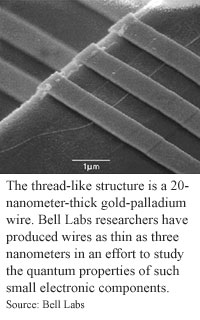
Tiny metal wires chart nanoelectronics
By Eric Smalley, Technology Research NewsMetal wires 10 atoms wide are providing clues about what lies ahead as the frontiers of nanotechnology and shrinking computer circuits are pushed further into the realm of quantum physics.
Researchers at Bell Labs have produced wires made of a gold palladium alloy that are only three nanometers, or about 10 atoms, thick. The wires are relatively lengthy at about a micron long.
The wires are not intended for making circuits in devices, but rather for studying how electrons behave in circuits at that scale. The work should help researchers find their way when they begin making electronic devices many times smaller than today's technology.
"If you look at a regular metal [wire], even if it was, say, on the order of a micron wide, you'd have to go to extremely low temperatures in order to see any quantum effects," said Bob Willett, a research physicist at Bell Labs. "We're able to see quantum effects at a hundred Kelvin with wires this small. So the quantum effects become much more pronounced." One hundred degrees Kelvin is -280 degrees Fahrenheit and absolute zero is -460 degrees Fahrenheit.
"These wires are sufficiently small that the electron can defuse across the wire width without changing its wave behavior. It doesn't get scattered," said Willett. "We want to understand the physics of what's happening with the electron propagation and the propagation with relation to the disorder in the materials. And this is a testbed for that."
The length of the wire makes it appropriate for studying what could happen in the interconnects between very small components in future electronic devices, he said.
One interesting effect the researchers have found so far is that the wire does not exhibit an odd behavior present in larger wires, Willett said. As the temperature decreases, the length over which an electron maintains its wave-like behavior increases because thermal noise diminishes. However, in larger wires this effect reaches a plateau.
"We found in the smallest wires... the phase coherence length does continue to increase as you drop down in temperature," he said.
Though these observations seem far removed from today's semiconductor factories, the research could help guide the direction of technological development.
"You want to know beforehand what can happen at these small dimensions," said Willett. "You don't want to be surprised by strange effects [after] you've made a huge effort to get down to this very small scale."
Devices that could make use of the quantum effects the researchers are studying in these tiny wires are probably 15 to 20 years away, he said.
Willett's colleagues were principal investigator Doug Natelson, Ken W. West and Loren N. Pfeiffer. They published their work in the September 25, 2000 issue of the journal Applied Physics Letters. Their work was funded by Bell Labs' corporate parent Lucent Technologies, Inc.
Timeline: Now; 15-20 years
Funding: Corporate
TRN Categories: Semiconductors and Materials
Story Type: News
Related Elements: Image; Technical paper "Fabrication of extremely narrow metal wires" in the September 25, 2000 Applied Physics Letters
Advertisements:
November 15, 2000
Page One
Biometrics takes a seat
Oversize oddity could yield quantum computers
Switch narrows molecular-macroscopic gap
Tiny metal wires chart nanoelectronics
Chip techniques block power leakage

News:
Research News Roundup
Research Watch blog
Features:
View from the High Ground Q&A
How It Works
RSS Feeds:
News
Ad links:
Buy an ad link
| Advertisements:
|
 |
Ad links: Clear History
Buy an ad link
|
TRN
Newswire and Headline Feeds for Web sites
|
© Copyright Technology Research News, LLC 2000-2006. All rights reserved.